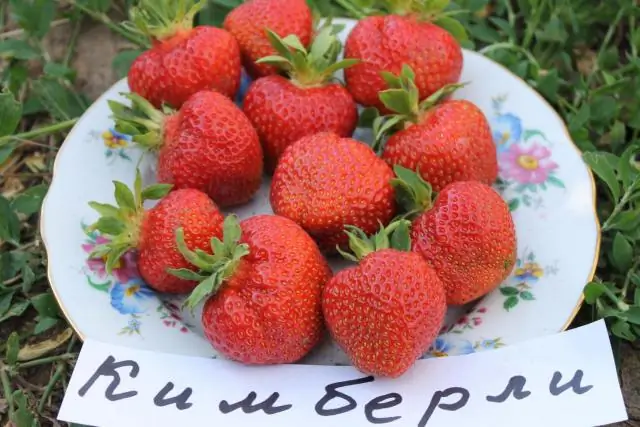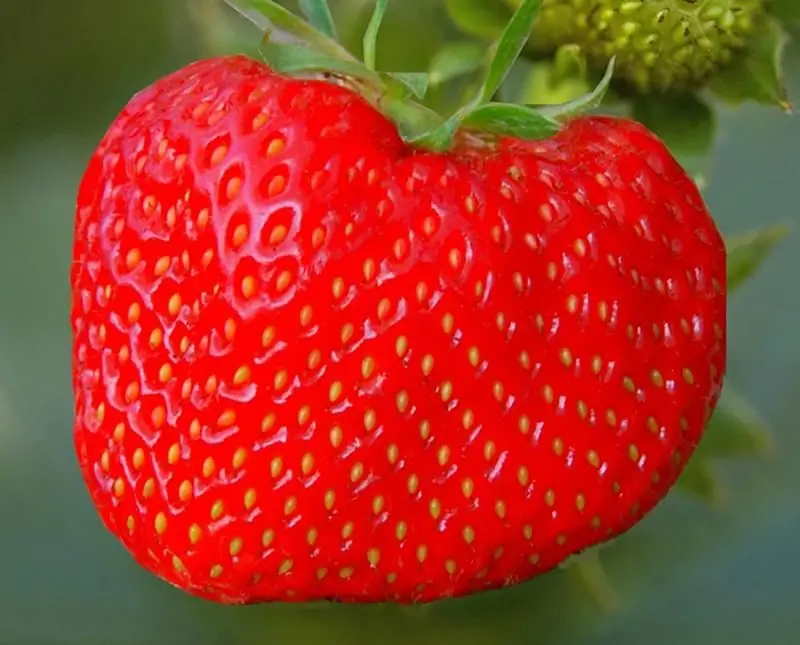
Table of contents:
- Author Bailey Albertson [email protected].
- Public 2023-12-17 12:53.
- Last modified 2025-06-01 07:32.
Strawberries Albion: harvest from spring to frost

A relatively young, but already quite popular variety of strawberries (garden strawberries) Albion every year gains more and more space in the beds. What are the features of its cultivation, breeding methods and differences from other varieties?
Content
-
1 Strawberry variety Albion
- 1.1 Characteristics of the Albion variety
- 1.2 Productivity of garden strawberries Albion
- 1.3 Description of the bush and fruits
- 1.4 Pros and cons of remontant varieties - table
- 1.5 Feature of the Albion variety - video
-
2 Planting and care
2.1 Approximate care scheme - table
- 3 Reproduction
- 4 Protection against disease
- 5 Harvesting and storage
- 6 Reviews of gardeners
Strawberry variety Albion
Albion is an American variety of large-fruited garden strawberries. Albion was developed in 2006 by breeders at the University of California by crossing Diamante and Cal 94.16-1. Breeding work began in 1997, and in 1998 the first crop was obtained. Since 1999, research has been carried out on the new variety, which culminated in final trials in 2005-2006.

Albion garden strawberries are a favorite of many
Large-fruited garden strawberries are usually called strawberries in our country, so as not to confuse them in words with small-fruited strawberries. Although these plants are related (genus Fragaria) and both of these berries are grown in gardens, there are differences between them.
Differences between strawberries and strawberries from a botanical point of view:
- berries are more aromatic, but much smaller and rounder in shape;
- flowers are divided into male and female;
- peduncles rise significantly above the leaves;
- the harvest is fundamentally less;
- fewer varieties.
Characteristics of the Albion variety
Strawberry Albion - remontant, is positioned as a variety of neutral daylight hours (fruiting lasts the entire warm season). Designed for cultivation in small garden plots and for industrial harvesting. It is considered one of the best commercial varieties.

Popular remontant varieties of garden strawberries
Albion garden strawberry yield
According to gardeners, the yield of the Albion variety is above average. Due to its remontant properties (3-4 waves of fruit ripening), one plant can produce from 0.5 to 2 kg of berries per season. Fruiting begins in late May - early June and continues until the October frost. The harvest (and taste) usually peaks during the second wave, and the berries remain large until autumn.
Description of the bush and fruit
The bushes develop well, reaching a height of 35-40 cm. The leaves are powerful three-toed. The flower stalks are strong and tall, so the berries rarely touch the ground. A characteristic feature of the leaves, especially the young ones, is their strong gloss. Their surface appears to be covered in oil. Fruits are large (30-50 g), dark red, beautiful conical shape. The pulp is dense, which allows you to leave the berries on the bush until they are fully ripe, when they pick up the maximum sugar and become most delicious. Albion tolerates storage and transportation well.

Albion berries on the scales
Pros and cons of remontant varieties - table
| Advantages | disadvantages |
| A repaired variety with a long fruiting period. | The harvest is greatly extended over time. |
| It tolerates hot weather, temperature changes well. | Does not like dry and poor soil, too abundant watering. |
| Stored for a long time, easily transfers transportation. | From visible (color) to full maturation, 1-2 days pass. |
| Sweet taste, pleasant aroma. | Already red, but unripe berry strongly sour. |
| Resistant to many diseases (late blight, rot, anthracnose). | May be exposed to chlorosis and tick attacks. |
Feature of the Albion variety - video
Planting and leaving
Like most varieties of garden strawberries, Albion loves warmth and sunlight, and this must be taken into account when choosing a place on the site. To get the maximum yield, you should prepare the soil for planting in advance. It is better to use slightly acidic (pH 5.0-6.5), light and medium in composition. 5-6 kg of organic fertilizers and 40-60 g of mineral fertilizers are applied per 1 square meter.
You can plant garden strawberries both in autumn and spring.
- If you start in early autumn, the plant will have time to get stronger before frost and prepare for fruiting. This factor is good for propagation with tendrils and transplanting bushes.
- If the seedlings are obtained from seeds or if you don't have the patience to wait for autumn, plant in spring. With this planting option, the first flower stalks must be cut off so that the bushes gain strength faster.
The distance between the bushes is 25-30 cm, and between the rows - at least half a meter.
The soil should always be moist, but not wet. With an excess of moisture, the berry loses its taste and becomes sour. To maintain moisture, you can use mulching the beds with grass. This will create more comfortable conditions for the roots, and subsequently rotted grass will serve as additional fertilizer.
Approximate care scheme - table
| Spring planting | |
| April | soil preparation: humus, compost - 5-6 kg / m 2, complex mineral fertilizers - 40-60 g / m 2 |
| May | planting, watering (1-2 times a week), sheltering from possible frosts, removing peduncles |
| June | root top dressing with carbamide (30 grams per 10 liters of water) - once every two weeks |
| Autumn planting | |
| August | soil preparation, fertilization (see above) |
| September | planting, watering, frost protection |
| End of September | top dressing with phosphorus-potassium fertilizer (PK 15-40) - once |
Reproduction
There are three ways to propagate garden strawberries:
- Antennae (the most common).
- Seed (most time consuming).
- By dividing the bush (the roughest).
For the first option, it is advisable to use only the first-order sockets (closest to the bush), and immediately remove the rest. To quickly form roots, the antennae are pinned to the ground. After the formation of a good root system, the seedling is transplanted to a new place. If the mustache is not enough, which is quite realistic in the case of Albion, you can use the second method.
For harvesting seeds, the ripe, large berries of the correct shape without any defects are selected. From them it is necessary to carefully cut off the top layer with seeds with a blade and then dry and separate the seeds from the skin.
Of course, you can buy ready-made in the store, but:
- there is no guarantee that this is exactly Albion;
- the germination capacity of purchased seeds is usually lower than their own;
- yours is always more pleasant and interesting, plus invaluable experience.
Seeds for germination are laid out (laid out, not buried!) On peat tablets and create a microclimate with high humidity (covered with glass or transparent film). After 15-30 days, depending on the quality of the seeds and conditions, roots and leaves will begin to form. And in another month, it will be time to start picking (planting), and then landing in the ground. And since this process is quite long, it is necessary to start planting strawberries in advance, in March-April. Daylight hours at this time are still short, so it is advisable to highlight the plantings additionally.
In the most extreme case, the division of the bush is used for reproduction and the cut off part is simply transplanted.
Disease protection
For most regions of Russia, in normal weather, Albion does not require special care and does not cause much trouble. In the spring, there is a high probability of chlorosis on the bushes (the first sign is the appearance of yellowness on the leaves). Iron chelate (antichlorosin) is very helpful in protecting against and treating this disease. It can be used for both spraying and root dressing. Usually, two applications with an interval of 10-15 days are sufficient.
Harvesting and storage
The fruiting period for this variety is extended over several months, which is very convenient for the safety of the crop. From June to October you will always have a fresh berry plucked straight from the bush. And for a long winter, garden strawberries can be frozen or boiled with compotes and jam. For several days, the berry can be stored in the refrigerator at a temperature of about zero. According to gardeners, the Albion variety is considered one of the best for storage and transportation.

Ripe Albion strawberry outside and inside
It is better to harvest at the stage of full maturity, when the color of the berries turns dark red, although I really want to pick them ahead of time. Only a fully ripe fruit will be both tasty and aromatic.
Gardeners reviews
Garden strawberry Albion is a cultivar with an extended fruiting period, good yield and disease resistance. The berries are large, tasty, easy to transport. Used for commercial berry growing and hobby gardening.
Recommended:
A Variety Of Garden Strawberries (or Strawberries) Kimberly - Description, Care And Other Features + Photo

Information on planting and breeding of Kimberley strawberries (strawberries), care, planting, harvesting. Description of the variety. Reviews of gardeners about Kimberly strawberries
Columnar Apple Of The President Variety: Description And Characteristics Of The Variety, Advantages And Disadvantages, Planting And Care Features + Photos And Reviews

The subtleties of growing a columnar apple of the President variety: rules for planting and caring for a tree, treatment and prevention of diseases, pests. Gardeners reviews
Chamora Turusi Variety Of Garden Strawberries - Features, Care And Other Important Aspects, The Difference Between Strawberries And Garden Strawberries + Photo

Everything about the Chamora Turusi strawberry variety: from planting and care to picking berries. Productivity, terms of fruiting, reviews of gardeners
All About Garden Strawberries (strawberries) Varieties Asia - Description, Planting, Care And Other Nuances + Photo

Description of the variety of garden strawberry Asia. Differences between strawberries and strawberries. Planting, care, reproduction. Protection against diseases and parasites. Reviews. Video. Photo
Everything About Garden Strawberries (strawberries) Queen Elizabeth: Description Of The Strawberry Variety, Planting, Care And Other Aspects + Photo

Description of the variety of remontant strawberries Queen Elizabeth, often called strawberries: pros and cons, features of fruiting, planting, care, photos and reviews
